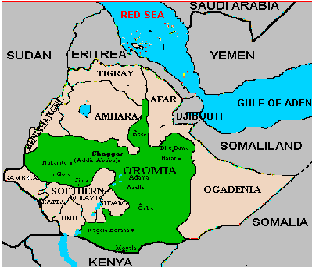By Qeerransoo Biyyaa
Oct 19, 2006 — It is not uncommon to see unexpected religious, ethnic, land conflicts in the Southern Ethiopia mainly in the states of Oromia and Southern Nations and Nationalities and Peoples (SNNP). These forms of conflicts happen whenever there are huge political developments in the regions to challenge the government. Exactly 14 days ago on the 5 of October there was a deadly religious feud between Muslims and Orthodox Christians leaving at least 4 dead reported Reuters.
The second religious conflict between the two groups happened at the start of this week with the scores of 9 victims. This incident was reported by agencies such as AFP and Reuters. You can consult online archives to confirm whether this holds.
The point is that these incidents follow two heavy political losses by the present Ethiopian government. First it has been rejected as a de facto government in the 2005 elections. Its second loss is the development of a powerful and diversified political alliance in the history of Ethiopia ever, Alliance for Freedom and Democracy (AFD) in 2006. Following that, the EPRDF/TPLF has been inciting ethnic, religious and land-based conflicts on a wider scale. The strategy of inciting and sustaining different forms of violence forms a specific strategy of the general divide and rule policy the regime is following. It targets at dividing the massively popular AFD member organisations as well as its supporters.
How does EPRDF/TPLF government incite these kinds of religious ethnic and land based violence? Here are some of the most common ways known to insiders who experience it daily:
Hiring government agents who pretend to be Muslims or Christians and who disturb religious rituals and disappear or mix with a group to fight another Killing the one person from a certain ethnic group and blaming it on another and spreading rumours that encourage vicious revenge and robbery Giving a land that belongs to a certain group and supporting the one it favours with fire arms These three are some of the wild ways the government uses to weaken a group or groups it perceives to be mounting a significant political threat or challenge. In all the above cases, conflicts grow from small scale or individual cases to vicious ones involving a wider group over time, finally resulting in genocide.
These are the mysterious tragedies that we are facing in Ethiopia, mysterious of course in the sense that the west cannot really understand what is going on just by looking at what is happening on the surface and calling it “sectarian violence” “religious riots” or “ethnic conflicts”. Often the conflicts are reported, but the ultimate causes are not mentioned in some of western reports. For instance, questions worth asking are why is the Ethiopian government indifferent when conflicts happen over extended periods? Why did it not at least minimise? Are the conflicts really religious, land based, or ethnic?
To go back to the issue of religious conflict, Christianity and Islam constitute the major religions in Ethiopia. The bleak scenario suggested by the current developments of religious intolerance secretly caused by the ruling party has become a topic of discussion among people in Ethiopia. What we are used to see was that the government uses its army to suppress protests and dissent, but now it is creating religious fault lines between groups and within a group as supplements.
It is up to every stakeholder including international spectators to pay attention and work harder toward preventing larger scenario of persons using machetes, knives and swords to wipe out fellow persons. Be aware that in the small-scale conflict, groups used machetes, knives, and swords. The international community and concerned international organisations must work on exposing how the government is using ethnic identity, land, and religion as causes of conflict to stay in power.
* The author is based in side Ethiopia, he can be reached at meettaa@gmail.com
Location: Horn of Africa; in what is today Ethiopia. Oromia is approximately located between 3 degree and 15 degree N latitude and 33 degree and 40 degree longitude. Size 375,000 Square Miles, or, 600,000 square kilometers; Larger than France, Italy, Switzerland, Belgium & the Netherlands combined. Population 40 million; 3rd. largest nationality in Africa; single largest nationality in East Africa.
WELCOME TO OROMONET
The Home of Oromo Views & headline News from the Horn of Africa
Gabcast! Gotoota Oromo Haa Yaadannu. #17 - Wallee.
Gabcast! Gotoota Oromo Haa Yaadannu. #17 - Wallee.

No comments:
Post a Comment
I am responsible for my posting.